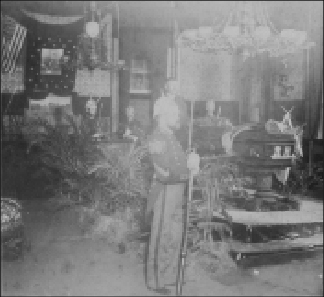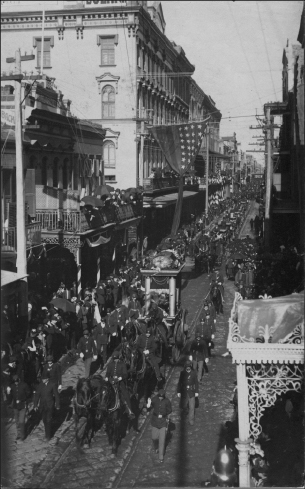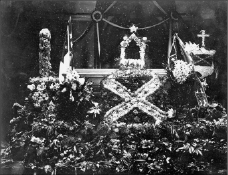Bloody Times (19 page)
Authors: James L. Swanson
After the tour Davis returned to Beauvoir. On June 3, 1888, he celebrated his eightieth birthday. Abraham Lincoln was only fifty-six when he was assassinated, and he had no time to savor his victory. Jefferson Davis had had twenty-three years to reflect upon his defeat. From all across the South, from people high and low, congratulations and gifts for Davis poured in.
One letter, from a former Confederate soldier, spoke for all the veterans who had survived the war. “As a native of Ponotoc, Miss., and as an ex-confederate, who entered the army at 17 years of age and remained till the last gun had fired, may I not claim a few moments of your time by tendering to you my congratulations on this your eightieth birthday?” the soldier wrote. “All of us are indeed proud that you have been permitted to remain with us until the ripe age of eighty and we pray earnestly that you may be permitted to enjoy many more years of health, happiness and prosperity. . . .”
But Jefferson Davis did not have many more years. He died one year later, in New Orleans, peacefully, with his wife’s hands folded into his.

Jefferson Davis lies in state in New Orleans.
There was a magnificent funeral in New Orleans, and Davis was buried at Metairie Cemetery. But everyone knew this was only a temporary resting place. It was understood that Varina Davis would select a permanent gravesite. Several states, including Mississippi, fought for the honor. In 1891 Varina chose Virginia. Davis would return to his capital city, Richmond.

The New Orleans funeral procession.
In 1893 Davis’s body was placed aboard a funeral train bound for Virginia. To those who remembered 1865, the sight of another presidential train winding its way through the nation was familiar and eerie. In Richmond a grand procession escorted the remains to Hollywood Cemetery.
Jefferson Davis had survived Abraham Lincoln by twenty-four years. Now, his journey also done, he joined him in the grave.

The Raleigh, North Carolina, funeral procession, on the way to Richmond.

Floral tribute at the Raleigh ceremonies.
The chase for Jefferson Davis and the death pageant for Abraham Lincoln are among the great American journeys. Like the explorations of Lewis and Clark, the settling of the West, the building of the transcontinental railroad, and the landing on the moon, the rise and fall of the two Civil War presidents, each a martyr to his cause, altered our history and added to our myths. The history is well known—620,000 dead, the overthrow of old ways of life, and the end of a great but flawed antebellum empire built upon slavery. When Lincoln and Davis fell from power, they also set in motion two myths—the legend of America’s emancipating, secular saint, and the legend of the Lost Cause. The assassination, nationwide mourning, and funeral for Lincoln; and the chase, imprisonment, and long Civil War afterlife of Davis haunt American history down to the latest generation.
* * *
In the years following Lincoln’s funeral, the melancholy curse that afflicted his family would not lift. During the months after Mary left Washington, there were rumors that she had plundered the White House of valuables; and in 1867, a scheme she hatched with her friend Elizabeth Keckly to exhibit her dresses for money—the “old clothes scandal,” as the press dubbed it—made her a national laughingstock. Tad, the president’s constant companion after Willie’s death, died of tuberculosis in 1871 when he was eighteen, having survived his father by just six years. The body of another Lincoln was put aboard a train. The tomb in Springfield was opened, and Tad joined Abraham, Willie, and Eddie. Mary continued to live as an unsettled wanderer and spent much of her time in Europe. Irrationally, she believed herself destitute. She made mad, vicious accusations of dishonesty and theft against her son Robert, which led him to have her committed to a sanitarium for four months in 1875. She posed for the notorious spirit photographer Mumler, who supplied her with the expected image of the ghosts of Abraham and Willie hovering above her. She finally returned to Springfield and moved into the home of her sister, Elizabeth Todd Edwards. It was the house she and Abraham had been married in. As she had after the assassination, Mary spent much time in seclusion in her room, longing for death. She died on July 16, 1882, surviving her husband by seventeen unhappy years. She joined her family in the tomb. The nation did not mourn her passing. Robert Todd Lincoln became a prominent attorney, businessman, and government official, but after his death in 1926, the Lincoln line died out within two generations. Today there are no direct descendants of Abraham Lincoln.
Varina Davis went on to live a fulfilling life after Jefferson’s death. She helped plan his funeral and took pride in how the South mourned him. In 1893, Varina oversaw her husband’s reburial in Richmond. In 1890, Varina published her book
Jefferson Davis, Ex-President of the Confederate States of America, a Memoir, by His Wife
. Jefferson had dedicated his memoirs to the women of the Confederacy, and in hers Varina remembered the men: “To the soldiers of the Confederacy, who cheered and sustained Jefferson Davis in the darkest hour by their splendid gallantry, and never withdrew their confidence from him when defeat settled on our cause, this volume is affectionately dedicated. . . .” Like her husband, she needed two fat volumes to tell her story. Unlike him, she unburdened her heart.
In 1891 Varina moved to New York City, a decision that confused many Southerners and disappointed others. While she left behind the Southern landscape of her past, she did not abandon her memories of it. She wrote articles, made new friends, maintained a literary salon, and created a Manhattan Confederate circle that included Burton Harrison, who had become a prominent lawyer, and his wife, Constance Cary Harrison. They, too, wrote about their lives and times in the old Confederacy. Varina Howell Davis died in 1906. All of her sons had preceded Jefferson in death, but through her daughter, Margaret, the family line lived on, and today the direct descendants of Jefferson and Varina Davis work to preserve the memory of their ancestors.
Little physical evidence of the Lincoln funeral train survives. The steam engines that performed flawlessly during the sixteen-hundred-mile journey were scrapped long ago. In 1866 the presidential car was auctioned and purchased by the Union Pacific Railroad. Afterward, the president’s funeral car enjoyed a few decades of celebrity but then, stripped of its decorations and furniture and suffering from neglect and decay, it perished in a fire. Souvenir photo postcards from the day depict a pile of collapsed, wooden ribs charred black. The other coach cars vanished, and the funeral train survives only in the dozens of photographs that were taken of it along the route from Washington to Springfield.
None of the majestic horse-drawn hearses, which had once caused the public to marvel at their size and extravagance, exists today. All of the catafalques save one—the one upon which Lincoln’s coffin rested when he lay in state at the U.S. Capitol, and upon which dead presidents still repose—are gone. From all the hearses and catafalques, only a few relics survive, scattered among historical societies and private collections: framed slivers of wood, swatches of black cloth, frayed bits of flag, strips of silver fringe, bullion tassels, dried flowers, and the like. From the New York City funeral, one of the twelve halberd-topped flagpoles mounted to Lincoln’s hearse survives, preserved by the assistant undertaker and identified for future generations by his sworn affidavit.
Not long after the funeral train left Springfield and returned to Washington, a legend spread of a Lincoln ghost train that rolled down the tracks each spring. An undated, fugitive newspaper clipping, found pasted in an old scrapbook from the late 1860s, is the only surviving evidence of the tale:
A Phantom Train
The Dead Lincoln’s Yearly Trip over the New York Central Railroad
A correspondent in the Albany (N.Y.)
Evening Times
relates a conversation with a superstitious night watchman on the New York Central Railroad. Said the watchman: “I believe in spirits and ghosts. I know such things exist. If you will come up in April I will convince you.” He then told of the phantom train that every year comes up the road with the body of Abraham Lincoln. Regularly in the month of April, about midnight, the air on the track becomes very keen and cutting. On either side it is warm and still. Every watchman when he feels this air steps off the track and sits down to watch. Soon after the pilot engine, with long black streamers, and a band of black instruments, playing dirges, grinning skeletons sitting all about, will pass up noiselessly, and the very air grows black. If it is moonlight clouds always come over the moon, and the music seems to linger, as if frozen with horror. A few moments after and the phantom train glides by. Flags and streamers hang about. The track ahead seems covered with black carpet, and the wheels are draped with the same. The coffin of the murdered Lincoln is seen lying on the center of the car, and all about it in the air and the train behind are vast numbers of blue-coated men, some with coffins on their backs, others leaning on them.
Many spirits, claimed the storyteller, accompanied Lincoln:
It seems then that all the vast armies that died during the war are escorting the phantom train of the President. The wind, if blowing, dies away at once, and all over the earth a solemn hush, almost stifling, prevails. If a train were passing, its noise would be drowned in silence, and the phantom train would ride over it. Clocks and watches would always stop, and when looked at are found to be from five to eight minutes behind. Everywhere on the road, about the 27th of April, the time of watches and trains is found suddenly behind. This, said the leading watchman, was from the passage of the phantom train.
More tangible than any alleged ghost trains are the railroad tracks. For the most part, the route followed by the Lincoln funeral train still exists, marked by ancient railroad beds and the villages, towns, and cities on the map when the train passed by. Yes, the aging iron rails forged by the Civil War were replaced long ago, but track locations rarely change, and many of the same railroad beds over which Lincoln’s coffin rode are still in the same place, a hundred and fifty years later. Few of the residents who live along the route today know about the torches, bonfires, arches, cannon fire, and huge crowds, or that Lincoln’s corpse once passed that way and perhaps even stopped in their town. Every day in America, thousands of railroad passengers, unbeknownst to them, follow the route of the funeral train.